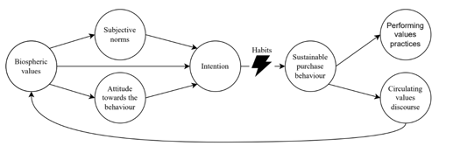Promoting sustainable purchasing behavior at Heijendaal
Several summaries have already highlighted the importance of purchasing in making the supply chain of Heijendaal more sustainable. And although this importance is growing, it remains challenging to actually build on this momentum and implement sustainable purchasing practices within and across the organizations. One challenge lies in how to actually move people to behave more sustainably. As, ultimately, it is the people within the organizations who have to be motivated to make more sustainable choices and hence improve sustainable performance. Therefore, this study focusses on how the role of behavior influences the sustainable purchasing decisions of employees working at Heijendaal.
Context and relevance
Sustainable purchasing is an important driver for organizations and supply chains to become more sustainable. Through the purchasing function, buyers and suppliers have to work together to choose and develop more sustainable products and services, but also to decide on how they can sustainably deliver the goods or services to the campus. This means that in a sense, the purchasing departments can function as gate keepers for sustainability in certain situations. However, after that, it is also required that employees actually make sustainable choices when ordering goods and services for themselves and for delivery to the campus, which often remains challenging. It is vital that the behavior of employees towards sustainable purchasing changes in order to make more informed decisions on their ordering behavior. Hence, by changing the ordering behavior of employees to become more sustainable, more sustainable products are ordered, but also orders may be bundled more efficiently, meaning that less deliveries have to be made to the campus. These options can therefore aid in making the supply chain more sustainable from the bottom up. This study looks at what sustainability actually means to the employees of the RU and HAN, and how this can be leveraged in making their ordering behavior more sustainable.
Research question
Based on this backdrop, the following research question was pursued:
How can the HAN and the RU improve the attitude towards sustainable purchasing behavior of their employees?
Research approach
This research was conducted by a master thesis student from Radboud University. For this research, the RU and the HAN were involved as individual cases and also compared to each other. Due to the ongoing COVID pandemic, the RUMC was not involved. To gain a good representation of the situation, 10 interviews were conducted from various levels of the two organizations, so managers but also operational employees doing the actual purchasing. During the analysis, an assessment was made on how choices to sustainable purchasing behavior came about for the employees of these two organizations using the theoretical framework on Sustainable Purchasing Behavior (SPB), after which it was investigated how this behavior could be leveraged by using different practices within and across the organizations. A brief description is provided in the tables below:
Concept | Description |
Biospheric values | Valuing all life on earth and thus having sustainable values as part of personal values by which a person regulates his or her own behaviour |
Subjective norms | External pressures with beliefs on how to live and how to act, influencing the behaviour of a person |
Attitude towards the behaviour | A person’s beliefs about either favourable or unfavourable outcomes of a certain behaviour |
Habits | Automatic, subconscious behaviour |
Table 1 Elements of Sustainable Purchasing Behavior
Concept | Description |
Performing values practices | The way of execution of the values, how the values are implemented and become normative |
Circulating values discourse | The way of transfer or sharing of values across the organization |
Table 2 Processes of value practices
Results
Based on an assessment of the data and the literature on sustainable purchasing, the following model has been designed to show how sustainable purchasing behavior is put into practice. Below a brief summary is provided highlighting the main results.

The first contribution was found in the different elements influencing the intention to perform SPB. The findings show that biospheric values positively influence the intention to perform SPB as the adoption of such believes creates awareness on the need for sustainability, e.g. employees intrinsically seeing the need for sustainability. Furthermore, the subjective norms appeared to have an influence on the intention as different forms of pressure resulted in performing sustainability practices. This indicates that by having pressures to perform a certain way, a person is more inclined to have the intention to perform the behavior, for example managers allowing employees to order more sustainably. Thirdly, the attitude towards the behavior appeared to have an influence on SPB. With this element, it depends on what the situations are that influence the attitude, and not if the presence of attitude positively or negatively influences the intention to perform SPB as is the case with the presence of biospheric values and subjective norms. The element of attitude towards the behavior needs to be analyzed as having either a more positive or negative attitude towards the behavior, with a more positive attitude strengthening the intention to perform the behavior.
Moreover, both the subjective norms and the attitude towards SPB seemed to be influenced by biospheric values, indicating that biospheric values have an indirect influence next to their direct effect on the intention. The subjective norms are influenced by biospheric values as the norms stem from sustainable beliefs, which is the case with the adoption of biospheric values. The attitude is influenced by biospheric values as the adoption of these values means that these people care about the environment, thus sustainability, leading to a more positive attitude towards SPB. A barrier to performing SPB is that of habits that seemed to surely happen within the organizations. Since habits follow from automatic behavior, and in this case thus replicating older orders, SPB is likely not to be performed. Furthermore, employees sometimes are not aware of more sustainable options.
Another contribution is found in increasing the sustainability performance through leveraging different practices. The intention to perform SPB leads to the actual performance of sustainability. It is logical that by performing SPB, sustainability values are put into practice. Simultaneously, the values appear to be distributed across the organization by performance of values practices. This indicates that these two processes of values practices occur at the same time and not one after another. This can for example be done through following up on the sustainability policy, creating alignment between programs and initiatives within the organizations or making an in-depth assessment of the sustainability impact of different products. Ultimately, by circulating the sustainability values discourse, these values are discussed and dispersed across the organization which can lead to adoption of biospheric values by employees. While discussing the values, they are refined to ensure more support is created which thus leads to the adoption of the values.
Conclusions, policy recommendations and directions for future research
This research aimed to find an answer to how the SPB of employees could be improved. Conclusions were drawn upon the findings one of which was about executing a thorough analysis of the sustainability of goods in order to create clarity for employees on these goods.
- For employees it often remains unclear which and why goods are sustainable. Here, a thorough analysis on why goods are sustainable is useful. Such an analysis helps to understand which goods should be chosen to purchase. For this situation, the organizations should hire a person who is responsible for this task. As there is “no problem with support base”, an improvement can be made here. For the HAN this person could already be there as they hired a sustainability manager who is responsible for the sustainability performance of the organization and thus has the knowledge and the reason to do this investigation. For the RU, items in the catalogue were already identified as sustainable and later on, non-sustainable goods were even removed from the catalogue.
- Another practical implication for the organization lies in creating awareness of partnerships with suppliers among the employees. It appeared to be that sometimes the suppliers are not known by the employees which indicates the mentioned unawareness. By creating clarity among the employees on this situation, an improvement in goods ordered at the partnered suppliers can be made. Consequently, the goods can be bundled together leading to a reduction in the number of movements to the campus. The most important issue for both organizations is to create clarity on why goods are sustainable and with which supplier these goods can be ordered.
- Furthermore, as the higher price of sustainable goods creates a big obstacle, a possibility is to have deliberations between departments with which the purchasing of sustainable goods is related. An example was given by the sustainability manager with Amber cars and with whom the responsibility lies for purchasing and complementary actions. Here, deliberation can be useful to allocate or partly combine budgets in order to divide the costs of sustainable goods. In the long term, the departments will benefit from such investments as is the case with the example of buying sustainable laptops, which was given by the ICT manager.
- Finally, the organizations can use their legitimate power to deny access to all options with which non-sustainable goods can be ordered. This is already done by the RU in the catalogue.
